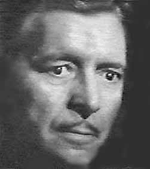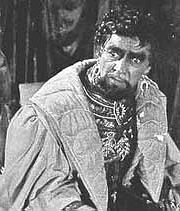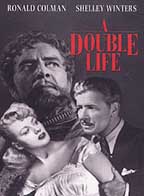FILM NOTES
FILM NOTES INDEX
NYS WRITERS INSTITUTE
HOME PAGE

(United States, 1947, 104 minutes, b&w, video)
Directed by George Cukor
Cast:
Ronald Colman. . . . . . . . . . Anthony John and Othello
Shelley Winters . . . . . . . . . . Pat Kroll
Signe Hasso . . . . . . . . . . Brita
Edmond O'Brien . . . . . . . . . . Bill Friend
The
following film notes were prepared for the New York State Writers
Institute by Kevin Jack Hagopian, Senior Lecturer in Media Studies
at Pennsylvania State University:
Constant immersion in someone else's reality is costly. In the theater, if you do it right, you rarely emerge from others' lives, the characters you play owning more of your head than you want to admit -- even to yourself. A Double Life refers to the two existences lived by one Anthony John, a versatile leading man on the Broadway of the 1940's. Tony John ought to be secure in his fame, but he wants to test it against the most demanding material in the actor's canon, Shakespeare's major tragedies. He knows thatOthellowill give him that test, and he also knows that his own ego must be strong if he is to survive 100 nights of the Moor without losing some of his own soul. What he does not know is that hisOthellowill run practically forever...
A Double Life was the first of seven films that Garson Kanin and Ruth Gordon wrote for George Cukor. The three would do seven films together, including Adam's Rib, Born Yesterday, and Pat and Mike, making it the most prolific and rewarding periods of Cukor's directing career. With the Kanins, Cukor ventured away from the security of the MGM lot. A Double Life was produced at Universal Studios, a studio which, since the petering out of its marvelous horror film cycle around 1940, had no discernible identity. In 1948, Universal was a blowzier, more raffish studio than the aristocratic MGM that had been Cukor's home since 1933. Universal was just the kind of place to make A Double Life. MGM was simply not ready to make the kind of gritty, disturbing film Cukor and the Kanins envisioned. (Indeed, it would be the success of A Double Life that would push MGM into film noir with films like 1950's The Asphalt Jungle and Mystery Street.) Cinematographer Milton Krasner could experiment with far murkier low-key lighting configurations than the high-key house style of MGM. And Universal pioneered in New York film noir location shooting; their 1948 Naked City is often cited as the most important of the postwar New York films, but A Double Life came first, its less well-known location photography making New York seem a place made of alternately tawdry low dives and claustrophobic, over-decorated Park Avenue apartments. At the behest of the Kanins, editor Robert Parrish and designer Harry Horner joined the production early, and stayed close throughout shooting. Together with cinematographer Krasner, they gave the film an eerily subjective sensibility, for although Anthony John's estrangement from reality doesn't begin until sometime near the middle of the film, the entire film is shot as if from his viewpoint. From Tony's perspective, the theater audience and the ordinary citizens of New York alike are part of the same shadowy, unreal population.
A Double Life wasn't the only classic-era film noir to be set in the world of the theater. Both 1948's The Velvet Touch and Alfred Hitchcock's 1950 Stagefright both featured actors (diva types, played by Rosalind Russell and Marlene Dietrich, respectively), who, like Tony John, grew so used to playing other characters that they lost the ability to play themselves. All three of these criminal protagonists, however, also have the actor's ability to tell a great story with conviction. Cracking their stories proves difficult, because they have come to believe those stories themselves; they are their own best audiences. The Kanins, like Cukor, were people of the theater, and many of the films and plays they created together or separately would be set in the world of the theater. But unlike the play The Actress, in which Ruth Gordon remembered her girlish dreams of willingly casting of her prosaic existence in favor of the far more romantic lives of dramatic protagonists like Juliet, A Double Life imagines playacting as a dangerous walk through a swamp of fear and pathology.
 Cukor had always been known as a "women's director." Ronald Colman as Tony John was a seasoned performer whose experience in movies went all the way back to the years of silent pictures; he required little technical advice from Cukor. So Cukor focused his attentions as a molder of performances on a lesser but crucial role in A Double Life. The film was actor Shelley Winters' first big part. Cukor had spotted her as far back as the talent search for Gone With the Wind, and now found in her just the brassy yet soulful dame the part of Pat Kroll called for. But Winters was profoundly unprepared, so much so that it appeared as if she would be unable to play the role for which she seemed so temperamentally suited. For her screen test, Cukor had Winters remove her brassiere, girdle, false eyelashes, and her makeup, and then let her hair down. He had her rehearse, and then, without her knowing it, filmed the rehearsal and submitted it as the test. Yet there was still more work to do. For her first scene alone with Ronald Colman, Cukor coached Winters through an astonishing 96 takes, took her to lunch, and then shot the scene another dozen times. To get inside the world of Pat Kroll, Cukor ordered Winters to watch the call girls who hovered near Hollywood's famous Schwab's drugstore, would-be stars who had slid downward into another kind of acting. From them, Winters got much of the paradoxical combination of hard-edged smuttiness and vulnerability she projects as Pat Kroll. The lonesome, falsely extroverted women of the night, said Winters, reminded her of her one-time roommate, a starlet named Marilyn Monroe.
Cukor had always been known as a "women's director." Ronald Colman as Tony John was a seasoned performer whose experience in movies went all the way back to the years of silent pictures; he required little technical advice from Cukor. So Cukor focused his attentions as a molder of performances on a lesser but crucial role in A Double Life. The film was actor Shelley Winters' first big part. Cukor had spotted her as far back as the talent search for Gone With the Wind, and now found in her just the brassy yet soulful dame the part of Pat Kroll called for. But Winters was profoundly unprepared, so much so that it appeared as if she would be unable to play the role for which she seemed so temperamentally suited. For her screen test, Cukor had Winters remove her brassiere, girdle, false eyelashes, and her makeup, and then let her hair down. He had her rehearse, and then, without her knowing it, filmed the rehearsal and submitted it as the test. Yet there was still more work to do. For her first scene alone with Ronald Colman, Cukor coached Winters through an astonishing 96 takes, took her to lunch, and then shot the scene another dozen times. To get inside the world of Pat Kroll, Cukor ordered Winters to watch the call girls who hovered near Hollywood's famous Schwab's drugstore, would-be stars who had slid downward into another kind of acting. From them, Winters got much of the paradoxical combination of hard-edged smuttiness and vulnerability she projects as Pat Kroll. The lonesome, falsely extroverted women of the night, said Winters, reminded her of her one-time roommate, a starlet named Marilyn Monroe.
 It seems hard to imagine now, but A Double Life was originally meant for Laurence Olivier. Hard to imagine because Ronald Colman so perfectly inhabited the role of the actor who allows his mind to be colonized by Shakespeare's charismatic villainy. Like another great film of the 1940's, Mildred Pierce, A Double Life was a scheme to get its leading performer an Oscar. Colman was anxious about doing Shakespeare on screen in the film's play-within-a-movie. Colman had been the screen's personification of English urbanity for a generation, but he had didn't think audiences would believe him as an Olivier-style stage actor. (The scenes involving the staged version of Othello were filmed separately, and in continuity. Colman was coached by Walter Hampden, an actor with all the experience in Shakespeare that Colman himself lacked.)
It seems hard to imagine now, but A Double Life was originally meant for Laurence Olivier. Hard to imagine because Ronald Colman so perfectly inhabited the role of the actor who allows his mind to be colonized by Shakespeare's charismatic villainy. Like another great film of the 1940's, Mildred Pierce, A Double Life was a scheme to get its leading performer an Oscar. Colman was anxious about doing Shakespeare on screen in the film's play-within-a-movie. Colman had been the screen's personification of English urbanity for a generation, but he had didn't think audiences would believe him as an Olivier-style stage actor. (The scenes involving the staged version of Othello were filmed separately, and in continuity. Colman was coached by Walter Hampden, an actor with all the experience in Shakespeare that Colman himself lacked.)
To reassure Colman, Cukor told the actor that the film had been designed to get Colman a long-overdue Oscar; Colman had been nominated three times before. Then, believing his own tale, Cukor and his associates set out to make it happen that way. Cukor and the Kanins personally invited members of the Academy of Motion Picture Arts and Sciences to see the film, and then greeted them after the screenings with enthusiastic reminders about the quality of Colman's performance. It worked. Colman's Oscar for Best Actor was regarded as entirely justified. Colman had made audiences believe that a person could be swallowed whole by his own fictional creation.
— Kevin Hagopian, Penn State University
For additional information, contact the Writers Institute at 518-442-5620 or online at https://www.albany.edu/writers-inst.
 A Double Life
A Double Life